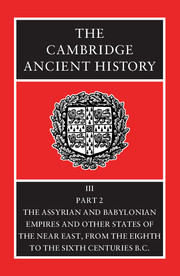Book contents
- Frontmatter
- Contents
- List of maps
- List of text-figures
- Preface
- PART I ASSYRIA AND BABYLONIA
- PART II THE EASTERN MEDITERRANEAN AND THE BLACK SEA
- 29 Israel and Judah from the coming of Assyrian domination until the fall of Samaria, and the struggle for independence in Judah (c. 750–700 B.C.)
- 30 Judah until the fall of Jerusalem (c. 700–586 B.C.)
- 31 The Babylonian Exile and the restoration of the Jews in Palestine (586–c. 500 B.C.)
- 32 Phoenicia and Phoenician colonization
- 33 Scythia and Thrace
- 33a The Scythians
- 33b Thrace before the Persian entry into Europe
- 34 Anatolia
- 35 Egypt: the Twenty-fifth and Twenty-sixth Dynasties
- Chronological Table
- Note on The Calendar
- BIBLIOGRAPHY
- Index
- Map 11: Phoenician and Punic sites in Spain
- Map 13: Scythia
- Map 14: Thrace
- References
33a - The Scythians
from 33 - Scythia and Thrace
Published online by Cambridge University Press: 28 March 2008
- Frontmatter
- Contents
- List of maps
- List of text-figures
- Preface
- PART I ASSYRIA AND BABYLONIA
- PART II THE EASTERN MEDITERRANEAN AND THE BLACK SEA
- 29 Israel and Judah from the coming of Assyrian domination until the fall of Samaria, and the struggle for independence in Judah (c. 750–700 B.C.)
- 30 Judah until the fall of Jerusalem (c. 700–586 B.C.)
- 31 The Babylonian Exile and the restoration of the Jews in Palestine (586–c. 500 B.C.)
- 32 Phoenicia and Phoenician colonization
- 33 Scythia and Thrace
- 33a The Scythians
- 33b Thrace before the Persian entry into Europe
- 34 Anatolia
- 35 Egypt: the Twenty-fifth and Twenty-sixth Dynasties
- Chronological Table
- Note on The Calendar
- BIBLIOGRAPHY
- Index
- Map 11: Phoenician and Punic sites in Spain
- Map 13: Scythia
- Map 14: Thrace
- References
Summary
PROLEGOMENA
In the first half of the first millennium B.C., new and powerful nomadic groups emerged on the Eurasian steppes to pose a military threat to more southerly urban and literate states and empires. By the sixth century B.C. a complex ‘core–periphery’ system had developed, in which true nomadism was only one element. The economic structure of steppe life changed and large-scale trade developed between the Greek Black Sea colonies and the vast new fortified centres of Scythian power.
The nomads can be traced at first archaeologically; later some names are attached to them in ancient texts. The most famous of these groups was known to the Greeks as the Scythians, against whom, Herodotus tells us, Darius the Great of Persia launched a massive and unsuccessful punitive expedition (CAH IV, 235ff). This chapter concerns the Scythians' rise to fame rather than their disappearance. By 500 B.C. they constituted one of the most powerful military forces in the known world.
- Type
- Chapter
- Information
- The Cambridge Ancient History , pp. 547 - 590Publisher: Cambridge University PressPrint publication year: 1992
References
- 1
- Cited by

